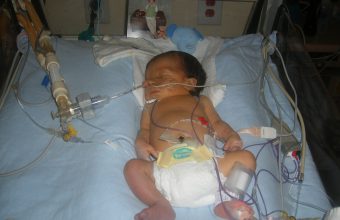I’d never heard of HIE until I was sitting across from the neonatologist at the Hospital for Sick Children the Monday morning following the birth of my son. This doctor explained that HIE was the reason for my son’s seizures that began at two days old and were persisting, despite aggressive treatment. HIE, I learned, stands for hypoxic ischemic encephalopathy and affects about 1 in 1,000 births.
What is HIE?
HIE stands for hypoxic (lack of oxygen) ischemic (restricting blood flow) encephalopathy (affecting the brain). Stats show that it affects somewhere around 2-3 of every 1,000 births, though it can also happen at any point in a person’s life. HIE is an event, not a diagnosis, though there are many conditions that are diagnosed in tandem with HIE.
What causes HIE?
My son’s HIE was likely a result of birth asphyxia due to intermittent cord compression, according to his labs and MRI imaging, but causes can include blood pressure issues in mom, cord entanglement and compression, fetal-maternal hemorrhage, placental issues such as abruption and placental insufficiency, intrauterine stroke, blood sugar issues, meconium aspiration, and shoulder dystocia.
According to University of California San Francisco Benioff Children’s Hospital, “If a significant risk factor such as fetal distress or low heart rate occurred during labor and delivery, or the baby needed help with breathing or low heart rate after delivery, HIE may be suspected.”
Properly trained birth professionals can detect the possibility of HIE, and help limit damage and initiate treatment, although research estimates that the majority — 70-80% — of cases are not preventable, and sometimes doctors won’t ever find the cause for a baby’s HIE event.
When the brain is deprived of oxygen, damage occurs. Some brain cells may be injured and recover, while others will die. According to Hope for HIE, a non-profit international support group for families affected by HIE, There are two stages of injury with HIE.
“The first stage happens immediately after the initial oxygen deprivation. The second occurs as normal oxygenated blood flow resumes to the brain. This is called “reperfusion injury” and occurs as toxins are released from the damaged cells.”
A child experiencing HIE can appear fine and then suddenly become very sick.
How is HIE diagnosed?
HIE is diagnosed using a combination of diagnostic tools, such as blood tests, evaluation of a baby’s presentation after birth or at the hospital, EEG, ultrasound and MRI.
There are three classifications of HIE based on something called the Sarnat scale — stage 1 (mild), stage 2 (moderate), and stage 3 (severe). The scoring also looks at level of consciousness, neuromuscular control, complex reflexes, autonomic function, lung and mouth secretions, and gastrointestinal motility.
Babies with mild HIE may show no symptoms. The presence of seizures automatically bumps you to at least stage 2, where my son fell. Stage 3 is the most affected and children often present as comatose and unresponsive.
What is the treatment for HIE?
Unfortunately, the only treatment that currently exists for HIE is what’s known as therapeutic hypothermia, or “cooling” therapy. Therapeutic hypothermia has been shown to reduce death and disability in many cases, and may be done to the entire body or via a cooling cap placed on the head. Certain conditions must be met to qualify for therapeutic hypothermia — for example, it must be initiated within the first 6 hours following injury, and it can only be done on full-term infants. My son did not qualify as we didn’t know anything was wrong until he was several days old.
Other treatment focuses on supporting the newborn as required. For us it meant anti-seizure medications while in the NICU and for a year after discharge, as well as a feeding tube and oxygen supports for a short time.
What else does HIE affect?
Some children will require a ventilator to help them breathe, use a feeding tube to eat and take medications, or use a mobility device like a wheelchair to get around. Many children with HIE will go on to be diagnosed with cerebral palsy. Others will go on to develop epilepsy. Some will have neurological conditions like learning disabilities or emotional regulation issues. Still others will have no noticeable lasting effects from their HIE injury.
Because the infant brain has the ability to “rewire” its pathways, children who are given a poor prognosis at birth may fare surprisingly well after injury. We were initially told our son would be vent-trach and feeding tube dependent, likely in a vegetative state for life, given the severity of his brain injury on MRI. He has since gone on to develop typically, defying those initial predictions. Our neurologist told us that for as much as we know about the human brain, we still know very little, and his “recovery” is simply one of those things that happens from time to time.
While the MRI is seen as the gold standard in diagnosing brain injury, and can give clues to possible ways a child might be affected by their particular pattern of injury, it’s not predictive. That’s probably one of the most frustrating things about HIE — that there is no rhyme or reason for why or how one child with the same injury can be unaffected and yet another severely affected. Families are often told to “wait and see” for their child’s outcome, which leaves little in the way of an action plan to help their child.
That said, early intervention therapy services such as physical therapy, occupational therapy, speech therapy, feeding and swallowing therapy, vision therapy and more, can help children with HIE to develop to their full potential. In the five years since his birth, my son has worked with physiotherapy and speech therapy to help with some issues. However, I feel like I’m constantly on the lookout for problems, and that I blame any little variation in “normal” as the possible result of his HIE. I still worry that he’ll develop epilepsy, despite him not having a seizure since being discharged from the hospital. While those thoughts steal my parenting joy when they pop up, I realize how lucky we are to be here and that there is still hope in our journey, no matter the outcome.
What supports are there for HIE?
Aside from community-based support and professional therapies, there is a thriving global support group called Hope for HIE. They run a Facebook group for families affected by HIE, and membership has doubled since I found them shortly after our diagnosis, with continued exponential growth. This growth is not because HIE is more prevalent, but because of the dedicated outreach and web presence of the group.
Parents can connect with others going through the same experiences and even find those local to them — we were able to meet another family in our area and it was immensely helpful at the beginning of our journey. Ultimately, their goal is to educate and support families by reminding them that there is always hope, no matter where your HIE journey takes you.
Tagged under: newborn,sickkids hospital,HIE,What is HIE,hypoxic ischemic encephalopathy,newborn health
Category: babies-kids,health






